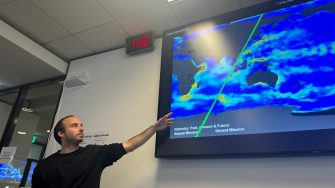
Bayesian inference provides an ideal platform for assessing parameter uncertainty for complex physical models, such as conceptual hydrological models. Sequential Monte Carlo (SMC) samplers are well suited for its implementation as they are effective in sampling from posterior distributions with the non-linear dependency structures and multiple modes often present in hydrological models. A challenge in implementing SMC samplers is in the construction of a suitable sequence of intermediary distributions leading to the posterior distribution, in such a way that the sampler performs both efficiently in that minimal computation is needed, and robustly in that the samplers particle population is effectively maintained. In this article we demonstrate that naive implementation of an SMC sampler in a hydrological model can cause the sampler to collapse. To address this, we propose a new method of dynamically constructing the transition path between the intermediary distributions that effectively increases the amount of computation at the point where it is needed to avoid this collapse. We analyse the performance of our approach through the analysis of real and simulated hydrological data, and discuss related SMC sampler implementation issues. In addition we consider the question of the appropriate number of particles in the sampler as the dimensionality of the model increases.
Refrences
Jeremiah, E., Sisson, S., Sharma, A., Marshall, L. (2012). "Efficient hydrological model parameter optimization with sequential Monte Carlo sampling." Environmental Modelling and Software 38: 283-295.
